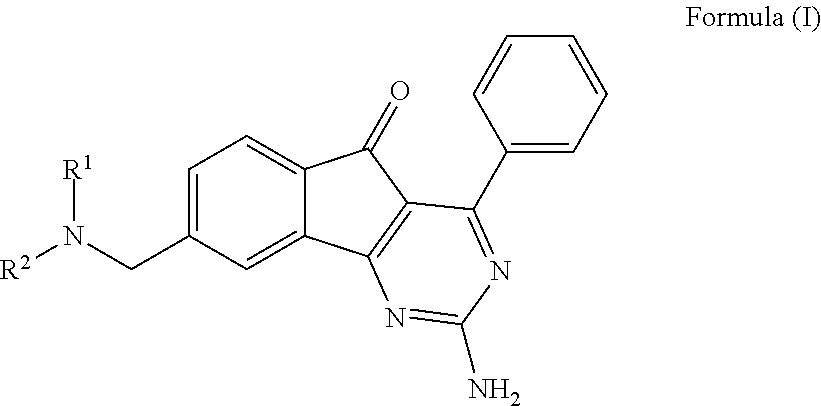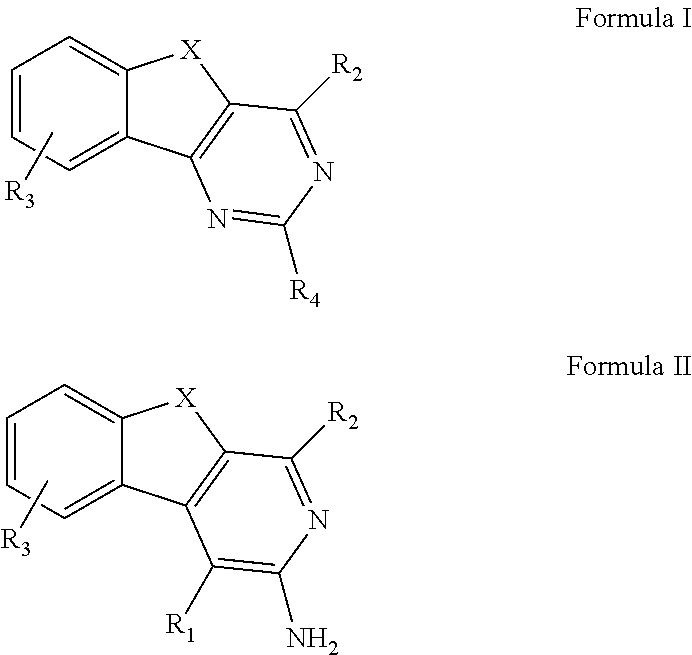ARYLINDENOPYRIMIDINES WITH REDUCED hERG CHANNEL BINDING
a technology of arylindenopyrimidine and herg channel, which is applied in the field of adenosine a1, a2a receptor antagonists, can solve the problems that a group of compounds has been unexpectedly found to have extremely low activity in blocking herg channel, and achieves the effect of minimizing cardiac toxicity risk
- Summary
- Abstract
- Description
- Claims
- Application Information
AI Technical Summary
Benefits of technology
Problems solved by technology
Method used
Image
Examples
example 1
Preparation of Enone (1)
To a mixture of 6-methyl-1-indanone (182.0 g, 1.25 mol) and benzaldehyde (90.0 mL, 0.89 mol) in 1.2 L of ethanol was added a solution of 62.0 g NaOH in 182.0 mL of H2O. Additional ethanol (1 L) was added and the solution was stirred for 3 h at rt. The resulting precipitate was isolated by filtration and washed with cold EtOH. The residue was dried in a vacuum oven overnight at 60° C. to yield 197 g (95%) of enone (1) as a white solid.
example 2
Preparation of Indenopyrimidine (3)
Guanidine-HCl (406 g, 4.25 mol) in ethanol (4 L) was neutralized by addition of solid NaOH (170 g, 4.25 mol) over 30 min. After a further 30 min, the solution was filtered and the residue washed with ethanol. The filtrate was then added to a solution of enone (1) (200 g, 0.85 mol) in 2 L of ethanol and the resulting mixture heated to 80° C. for 18 h. After cooling to 0° C., the suspension was filtered to yield 219 g of pyrimidine (2).
Pyrimidine (2) (219 g) was dissolved in 2 L of DMF and heated to 100° C. for 18 h while air was vigorously bubbled through the solution. The mixture was diluted with water and the resulting precipitate isolated by filtration. The resultant solid was dried in a vacuum oven for 18 h at 60° C. to yield 172 g (70%) of indenopyrimidine (3) as a yellow solid.
example 3
Protection of Indenopyrimidine (3)
A solution of indenopyrimidine (3) (200.0 g, 0.70 mol), DMAP (8.5 g, 0.07 mol), K2CO3 (289.0 g, 2.10 mol), and (Boc)2O (459.0 g, 2.10 mol) in 1.4 L of EtOAc was stirred at rt for 18 h. The reaction mixture was diluted with water (2 L) and EtOAc (3 L). The organic layer was washed with water (3×1 L). During the water washes a solid precipitated, which was isolated by filtration to yield 179 g of (4). The filtrate was evaporated to yield and additional 179 g of (4). The portions were combined and dried in a vacuum oven at 40° C. for 18 h to yield 275 g (81%) of (4) as a yellow solid.
PUM
| Property | Measurement | Unit |
|---|---|---|
| Force | aaaaa | aaaaa |
| Molar density | aaaaa | aaaaa |
| Molar density | aaaaa | aaaaa |
Abstract
Description
Claims
Application Information
 Login to View More
Login to View More - R&D
- Intellectual Property
- Life Sciences
- Materials
- Tech Scout
- Unparalleled Data Quality
- Higher Quality Content
- 60% Fewer Hallucinations
Browse by: Latest US Patents, China's latest patents, Technical Efficacy Thesaurus, Application Domain, Technology Topic, Popular Technical Reports.
© 2025 PatSnap. All rights reserved.Legal|Privacy policy|Modern Slavery Act Transparency Statement|Sitemap|About US| Contact US: help@patsnap.com



